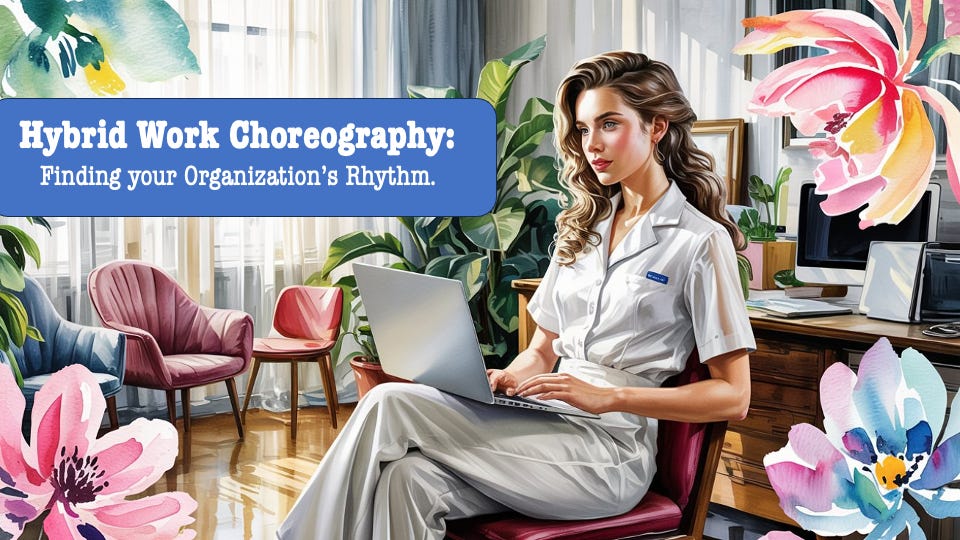Imagine an orchestra where half the musicians perform from a concert hall while the other half play remotely from their homes. Without a skilled conductor, the music would quickly fall out of sync, creating chaos instead of harmony. This metaphor perfectly captures the challenge organizations face today with hybrid work models—a complex balancing act requiring precision, coordination, and adaptability.
For organizational development (OD) practitioners, hybrid work is not just a logistical shift; it’s a fundamental transformation of workplace culture, employee engagement, and operational dynamics. The question is: Are you orchestrating a masterpiece or creating dissonance?
Let’s explore how to fine-tune hybrid work strategies, examine alternative approaches, and highlight some important cautions to help you lead your organization through this revolution.
Hybrid Work: One Size Does Not Fit All
Hybrid work models come in many shapes and sizes, reflecting differences in industry demands, workforce preferences, and leadership philosophies. Here are some common styles:
1. Flexible Schedule: Empowering Employee Autonomy
In this model, employees have the freedom to choose when and where they work within broad guidelines. This approach fosters trust and respects individual work rhythms, boosting morale and engagement. However, it requires clear communication and well-defined expectations to maintain accountability and prevent confusion.
2. Fixed Hybrid: Structured Balance
Some organizations adopt a fixed hybrid schedule, where employees spend certain days in the office and others working remotely. This approach provides predictability and helps maintain team cohesion but may feel restrictive to employees who prefer more autonomy. Regular feedback and flexibility within this structure can help address these concerns.
3. Remote-First: Prioritizing Digital Collaboration
A remote-first model emphasizes working from anywhere, with occasional in-person meetings for team bonding or strategic planning. Success here depends on strong digital infrastructure, asynchronous communication, and a culture of trust and ownership.
4. Office-First with Flexibility
Certain industries or roles require a physical presence, leading to an office-first approach with limited remote options. While this can support operational needs, it risks alienating employees seeking flexibility. Leaders must ensure that in-office requirements are justified and balanced with employee well-being.
Best Practices
To create a thriving hybrid workplace, OD practitioners should focus on these key strategies:
Redesigning Office Spaces
The role of the office is evolving from a place for individual work to a hub for collaboration and connection. Organizations are transforming traditional desk setups into flexible, collaborative zones that encourage interaction when employees are on-site.
Leveraging Technology
Effective hybrid work depends on the right tools—cloud-based collaboration platforms, video conferencing, project management software, and even emerging technologies like virtual reality for immersive meetings. These tools help bridge the gap between remote and in-office employees, ensuring everyone stays connected and productive.
Building an Inclusive Culture
Hybrid work can unintentionally create divides between remote and in-office teams. To foster inclusivity:
Encourage equal participation in meetings by using features like chat, polls, and breakout rooms.
Recognize and celebrate achievements across all locations.
Train managers to lead distributed teams with empathy and clear communication.
Avoiding Pitfalls
While hybrid work offers many benefits, it also presents challenges that OD practitioners must proactively address:
Communication Silos
Remote employees can feel left out of informal conversations and decision-making. To prevent this, organizations should use shared digital platforms for updates and schedule regular check-ins to keep everyone informed and engaged.
Overlooking Employee Well-Being
Without face-to-face interaction, signs of burnout or stress may go unnoticed. Regular wellness surveys, open conversations about workload, and mental health resources are essential to support employee well-being.
Security Vulnerabilities
Remote work increases exposure to cybersecurity risks as employees access systems from various locations and devices. Organizations must invest in secure networks, provide training on safe online practices, and enforce strong data protection policies.
Lessons
Various industries have tailored hybrid work to their unique needs:
Technology and Creative Fields: Often favor flexible or remote-first models that emphasize autonomy and innovation.
Finance and Professional Services: Tend to prefer structured hybrid or office-first approaches to maintain compliance and client service standards.
Manufacturing and Healthcare: Typically require more on-site presence but may incorporate flexible scheduling where possible.
These examples illustrate that hybrid work strategies must align with organizational goals, workforce needs, and operational realities.
Doing Your Hybrid Work Symphony
Hybrid work is more than a trend—it’s a fundamental shift in how organizations operate. For OD practitioners, the challenge is like conducting an orchestra: balancing autonomy with structure, technology with human connection, and flexibility with accountability.
Success depends on adaptability. By listening to employee feedback, investing in the right technology, redesigning physical spaces, and fostering an inclusive culture, organizations can transform potential chaos into harmony.
So, ask yourself: Is your organization ready to compose its hybrid masterpiece? The future of work is here—let’s make it resonate!
NOTES
1. Basic ODPN Courses
In-person from 8am-5pm in the Meralco Power Tech, Ortigas on the dates mentioned.
Essentials of OD, Ms Milalin Javellana and Ms Tita Puangco, April 22
Diagnosing Organizations, Dr Joy Teng-Calleja, PhD, RPsy, June 17
Designing Effective OD Interventions, Dr Melissa Reyes, PhD, August 20
Process Observation and Analysis, Dr Josephine Perez, PhD, RPsy, September 18
Register here. or message or call ODPN Secretariate 0925.553.2342.
2. Get Ready and Save the Day. The ODPN’s ODLab25: Force for GoOD will be held late July 31 to Aug 1 in Martian Hotel, Zamboanga City. Watch this space for more announcements soon.
3. Forthcoming Ed Canela’s AI Seminar Series
3.1. Leadership in Managing Change and Innovation on May 10, 2025 (9:30 to 12:00) and
3.2. AI for Teachers and Educators on June 5, 6, and 7, 2025 (8:00 to 12:00 NN Zoom), SAIDI Graduate School of Organizational Development and Planning. Contact: Ms Cynthia Cruz AT cecruz@SA
3.3. Basic AI: Efficiency with Responsibility (AI for Book Publishing): 6 Cohorts (by invites only) April 22 and 23 (2 cohorts), May 21 (2 cohorts) and May 22.
3. 4. Aid4Business (for MSMEs) Institute for Small Scale Industries University of the Philippines (UP ISSI) 14 to 16, October 2025. Register here.
.




